Nancy Duarte's Blog, page 31
September 9, 2011
It's All Geek to Me

The description of the fictitious Turbo Encabulator has long been used by engineers to warn against the use of technobabble. It has a lengthy and fascinating history, which includes this 1977 performance by Bud Haggart.
There is most definitely a lesson here about avoiding the use of confusing jargon in our presentations. We should be conscious of our audience and sensitive to their familiarity with the terms that we use. We should only use jargon, acronyms and other technical terms if we are sure that our audience will understand them. If there is the slightest chance that they won't understand, then we need to simplify our language. Remember, if they can't understand your message, they can't adopt it.
Here at Duarte, we also saw this as a challenge. We believe that visuals can help bring clarity to otherwise confusing information. So, we took this on as an exercise in graphic recording, wondering if illustrating this epic masterpiece of nerd-dom might somehow make sense out of the confusion. Here are the results of our efforts:
Now re-listen to the video while looking at the visual. Does it help? Can using a visual make even a purposely confusing, technical-jargon-filled message clearer? What do you think?
So, if you have very technical information to convey, consider evaluating the words you use and eliminating jargon that won't resonate with your audience. Then, visualize! Use a picture to replace those thousand (technical) words. If you do, your presentations will be so strong, it will be as if they are powered by the modial interactions of magneto reluctance and capacitive deractants!






August 31, 2011
We've got spirit, yes we do!

If you're at all familiar with Duarte, you know we're more fun than the average bear. And bears are a pretty good time. Take Yogi for example. When he's not stealing your lunch, that guy is a hoot.
But I digress.
Duarte is fun.
Case in point, last week marked Duarte's 4th Annual Spirit Week. This year's theme: Summer Through the Ages. Every day, we paid homage to a different era, by dressing up and doing an activity appropriate to the time period. We ended with week with a (dress-down) day at the park, complete with good eats, cold drinks, and a Spirit Week Relay Race.
Check out the photos below, and hearken back to the good (and maybe not-so-good) ol' days.
MONDAY – '80s DAY

Totally.

Jump (For My Love)

Babies of the '80s
TUESDAY – '70s DAY

Duartians, diggin' it.

Our pets rock.

A paisley pet.

Sleaziest frame salesman this side of the Mississippi.
WEDNESDAY – '60s DAY

Mad Men are standing, hippies are sitting in.

Mad Men & a madman.

Jam sesh.
THURSDAY – '50s DAY

Too cool for school. Or work.

Wanna rumble?
FRIDAY – PICNIC DAY!

Relay Activity # 1 - Water Cup Fill 'er up

Spoonful by lovin' spoonful.

Nothin' but bucket.

Relay Activity # 2 - Picture Puzzle

They don't call it a relay RACE for nothin'.

Relay Activity #3 - Ahem, cornhole.

Winners of the Spirit Week Relay! (And proud owners of the coveted rainbow giraffe trophy.)

The gang's (almost) all here.
Big thanks to Mark, Nancy, and all my fellow Duartians for making Duarte such a spirited place to work.
Yay,
Paula






August 18, 2011
Camille Seaman on Taking Photos and Taking Risks

Photographer Camille Seaman's daughter was watching Storm Chasers on the Discovery Channel one day, when Camille stopped what she was doing to admire the storm's light.
Her daughter noticed her and said, "Mom, you should do that!"
Three days later, she was.

Camille's documentary-style photographs reflect some of nature's most breathtaking phenomena. Aside from storm chasing, her work has taken her to both Polar Regions. The resulting photos can be seen in her book The Last Iceberg.

In addition to receiving many awards, Camille has shown her work at the National Academy of Sciences in Washington DC and at the 2011 TED Conference.
Recently, we were lucky enough to have her share her work with us. During her talk, you could hear the collective gasps coming from the audience, which is an especially impressive feat for 8:30 a.m. on a Monday morning. But if you take a look at the photographs, you'll see the reason for our amazement.

Nancy sat down to talk with Camille after her presentation:
Nancy: I love how you capture the beauty and the magnitude of storms because sometimes we only see the destruction. What was your inspiration for showing this side of the storm?
Camille: I think everything has two sides. The creation aspect of these storms is really undervalued and overlooked. The reason that we have such fertile Great Plains is because we have these storms. You can't have one without the other.
It's the same with the Polar Regions. We have this wonderful temperate zone because we have these two Polar Regions. You take that away, and things are going to get crazy. I'm really trying to show people, to look at things from a different perspective.
Nancy: Your photography is almost spiritual in some ways. I was curious what makes you want to capture the emotion of these huge natural phenomena?
Camille: I think probably because I allow myself to feel it before I photograph it. It's very important for me personally that someone feel what I felt, not just see what I saw. A photograph has not achieved its point if somebody doesn't feel something.
Nancy: Your work sounds very dangerous, is it?
Camille: I think it could be. I'm not a reckless person, and I think everything can be responsibly done. I try to be as safe as I can in everything that I do. I think a lot of people wouldn't do what I want to do because they have some fear that something is going to happen. I have some hope that something is going to happen.
Nancy: You're so busy, successful and adventurous. What's it like to be a mom and be so dedicated to producing amazing work?
Camille: I think it's really important for my daughter to know that being a mother does not negate the necessity for her to live her purpose, to follow her dreams, or to do what she feels is important. In fact, it amplifies it. Being a mother really made me want to stand up and say, "I cannot leave this planet in the shape that it is for my child." She's, in many ways, been the inspiration.
Nancy: So, you're a TED Fellow. I've heard that everyone's life changes after TED. How has your life changed?
Camille: What TED really did for me was make me feel valid and recognized in a way that nothing else has to this point. With that, I think, comes an ability to be more fearless, more able and willing to say, "I'm going to do it."
Camille's prints are available through galleries in major cities.






August 12, 2011
Has the Goon Squad Come For PowerPoint?

When Helen Fielding used a diary to tell the story of Bridget Jones, this stylistic choice seemed logical: the journal format allowed the reader to see the seemingly small details of Bridget's everyday life. But what if Bridget had written her diary in a very unusual format? In her recent Pulitzer Prize winning novel A Visit from the Goon Squad, author Jennifer Egan dared to explore this question by writing an entire chapter of her novel in the form of PowerPoint slides. As one of her characters – a twelve-year old American girl named Alison – struggles to understand her complex emotions, she chooses to use charts and diagrams rather than traditional prose.
Great Rock and Roll Pauses View another webinar from JenniferEgan
In an interview with the Office Show, Egan explained that she was curious about PowerPoint as it seemed that "no one used the word memo or paper or presentation any more – it was always PowerPoint."
She discovered in writing the chapter that PowerPoint allowed her to tell different stories than conventional fiction, to detail Alison's segue of thoughts or to reveal the structure of small moments such as the attempts of Alison's brother – a child with Asperger's – to communicate his love to their father. The format also allowed her to control the pace of the story by inserting pauses in a way that can't be properly communicated with words. A novelist can indicate via text that a pause occurred, but the reader is still actively engaged in reading those words. Instead, by visualizing a pause between the character's thoughts and actions, PowerPoint allows the novelist to in effect stop time in the reader's mind.
Egan believes that the PowerPoint chapter is essential to the central story of her book because it pulls the different themes together into a cohesive whole. But how well can this technique be replicated? What lessons should we draw from Egan's use of PowerPoint?
Egan chose PowerPoint to reveal the structure of small moments rather than emphasizing the connective tissue between moments, the focus of most conventional fiction. But it's telling that this technique was used to convey the story of only one chapter and one set of characters. While she may have discarded the connections between moments in this single chapter, its placement within the overall narrative weaves it within the fabric of the broader story arc.
PowerPoint cannot be a substitute for good story-telling – this is why Egan's chapter works, and why PowerPoint is not actually a replacement for memos or papers or presentations. Each of those mediums relies on the connective tissue between ideas. For papers and memos, writing serves this purpose: the author must spell out their ideas and the transitions between them, as Egan does when she writes conventional fiction. For presentations, the speaker plays this role: the slides may provide visual cues and represent distinct ideas, but the presenter is what ties the slides together.
The true achievement of Egan's PowerPoint chapter is demonstrating how the use of media-in-media can enhance the overall quality of a story when used well. The placement of the chapter within a more conventional novel brought to life otherwise unobtainable details. This should serve as a powerful reminder to presenters who believe that their slides are the heart of their presentation. PowerPoint is most successful when used as media-in-media: not as a stand-alone presentation, but as a tool to aid in the story that the presenter is telling.
Read more about A Visit from the Goon Squad at Jennifer Egan's homepage.






August 4, 2011
Take Your Meetings by Storm…Gamestorm, That Is

The forecast for Friday, July 22nd at Duarte called for heavy downpours of creativity with intermittent showers of inspiration accompanied by flurries of sticky notes, pens and paper. The deluge of out-of-the-box thinking began mid-morning and continued throughout the day as Dave Gray and Sunni Brown hosted their day-long Gamestorming workshop, designed to equip individuals with tools to change boring, unproductive meetings into engaging, productive (and even fun) game-like encounters.
The class gave me the perfect opportunity to do some visual note-taking. Below are a few pages of my notes. Scroll down to the bottom of the post to see the rest.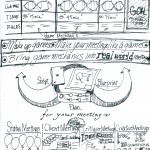
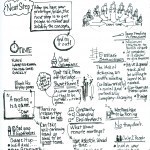
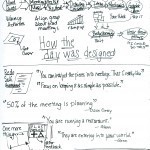
Sunni and Dave began the day by building trust and commeriaderie within the group through a series of games. One such game—World Café—literally brought attendees closer together as they answered questions about themselves within a series of concentric squares, starting with general questions in the outermost band and ending with more personal questions in the innermost square.

To get everyone on the same page about the pitfalls of poorly designed meetings, Sunni and Dave had attendees role play a typical meeting and assigned some roles (nay-sayers, "yes" people, problem solvers and meeting disrupters) for added realism. Who knew that a meeting to come up with a new name for adult diapers could get so heated?

For the meat of the day, Dave had participants brainstorm all of the different meetings that they attend and then had them cluster those into categories on the wall. Four distinct groups emerged—status meetings, client meetings, critiques and creative/ideation meetings. These served as the fodder for the meeting re-design activities throughout the day, as teams adopted each of these meetings to reimagine.

Dave then had groups ask a series of firestarter "what if…" questions to help them envision each of these meetings in a new way. Questions like, "If you could wave your magic wand, what would happen?" helped people break through previous assumptions about meetings in order to come up with new ways of designing them.

From there, Dave and Sunni led the group in some sketching exercises (Graphic Jam!) so they could visually communicate their ideas to others. Teams developed vision drawings of their reimagined meetings and shared them with each other.
Sunni went through the anatomy of a game and Dave had the group brainstorm game mechanics—points, territory, surprise, challenge, race, taking turns—so that teams could bring elements of their favorite games into their meetings and thus make them more enjoyable and engaging.

Teams worked together to develop a pitch for their new type of meeting and presented them to the group. It was amazing to see the ideas that were generated—a status meeting run as if it were an ESPN sports show, a critique meeting where attendees punched train-like tickets to establish evaluation criteria, a client meeting that involved card laddering and secret voting, and a creative/ideation meeting that started with 20 questions and ended with attendees presenting their ideas to a "shark tank." Amazing. Now those are meetings I would like to attend.
To wrap it all up, Dave and Sunni asked each participant what they would take back with them to their offices and gave attendees a look behind the curtain to see how they had used the principles of Gamestorming to design the day's workshop, which in hindsight felt much more like an enjoyable day playing games (where we happened to learn a ton of valuable skills) rather than some day-long information dump. I guess it works!
"A meeting is a game," said Dave Gray, "there's no reason it can't be fun." Imagine if more of our meetings incorporated principles of games in them. I think they would inspire a lot less aggrevation, agitation, and apathy and instead evoke anticipation, action and appreciation.
Below are Eric's visual notes from the workshop.
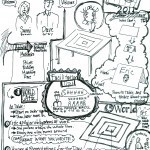
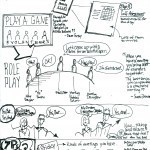
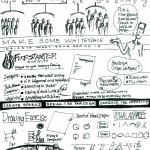
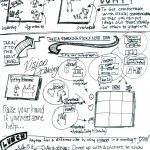
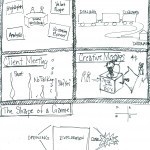
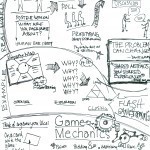






July 21, 2011
If the Medium is the Message, Would McLuhan Like PowerPoint?

Marshall McLuhan was one of the earliest scholars to discuss the changing nature of media in the electronic age and today would have been his 100th birthday. Famous for coining the phrase "the medium is the message," he devoted a great deal of attention to explaining how television changed the way the audience understands and participates in content. In his commentary on the landing of Sputnik, he called this new type of viewer a "simultaneous man" who prefers "flexibility and diversity" and lives in a "global theatre." "On Spaceship Earth there are no passengers; everybody is a member of the crew." He unpacked some of these ideas on the television program Our World in 1967.
McLuhan's ideas have recently resurfaced, as many are now applying his theories to the proliferation of electronic media forms. If television once created a generational gap between parents and their children, one can only wonder what McLuhan would have thought of the internet and the new era of transmedia storytelling.
In McLuhan's posthumous work Laws of Media, he argued that all forms of media have a tetrad of effects, or four different types of influence on society. He posed these effects as questions: What does the medium enhance? What does the medium make obsolete? What does the medium retrieve that had been obsolesced? What does the medium flip into when pushed to extremes?
Although McLuhan focused most of his writing on television, it is worth thinking about how his ideas intersect with another medium – the presentation. Unlike television, presentations often include a combination of in-person communication and electronic media that offers good presenters an opportunity to use their medium to engage their audience.
But how do presentations fit into McLuhan's tetrad? The answer may depend on what the presenter does well. For presenters who give thought to how to use their slides successfully, presentations can enhance communication, and form a connection that causes the audience to embrace the speaker's goals. They can retrieve the spoken word from seeming obsolescence in our visually focused culture (TED talks come to mind). For presenters who use technology poorly, however, mediums like PowerPoint run the danger of making the speaker themself obsolete as the audience focuses on the slides instead of the story. Taken to the extreme, they may ultimately flip PowerPoint into obscurity as bored audiences try to find ways of avoiding yet another bad slideshow. In order to prevent this fate, presenters should consider taking McLuhan's advice and embrace the needs of "simultaneous man": flexibility, diversity, and a need to be engaged in a meaningful way.
To explore more of McLuhan's ideas, this great commemorative site celebrates his life. Many examples of his work are now available electronically, marking his part in our cultural zeitgeist. He even appeared as himself in the film Annie Hall.
Perhaps McLuhan's ideas can help inspire our next great communication theorist, as he has helped inspire us here at Duarte!












